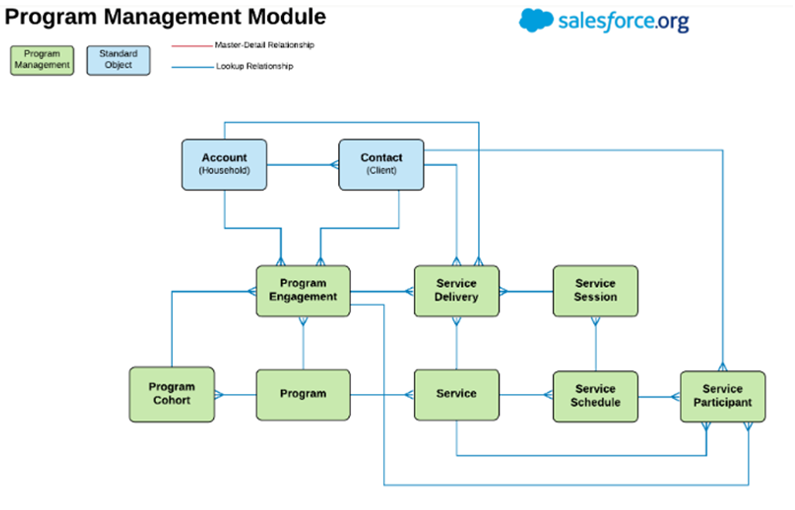The Program Management Module (PMM) seamlessly integrates with the Non-Profit Success Pack (NPSP), providing nonprofit organizations with valuable tools to enhance their planning, execution, and monitoring of diverse programs. This integration is designed to streamline processes and offer comprehensive insights into the impact of organizational programs.
By combining PMM with NPSP, nonprofit entities can optimize their program management workflows. The module facilitates more efficient planning by offering features that aid in the creation and organization of program activities. It also supports effective execution through tools that enhance coordination and communication among team members.
PMM integrated with Salesforce NPSP enables robust monitoring capabilities, allowing organizations to track and evaluate the progress and outcomes of their programs. This functionality enhances decision-making by providing real-time data and performance metrics, enabling nonprofits to make informed adjustments to their strategies.
Key Components and Aspects:
The Program Management Module within Salesforce NPSP incorporates various essential components and features, providing a comprehensive solution for effective program management. Let’s explore each aspect in detail:
1. Program Tracking: Efficiently oversee and manage crucial details of projects, parent programs, and their phases. This functionality enables organizations to closely monitor the progress of diverse initiatives, ensuring a streamlined and effective approach to program management.
2. Constituent Management: Establish and monitor relationships between programs and clients, involving contacts, organizations, and other customizable objects. This feature offers a holistic view of the connections between programs and the constituents they serve, fostering improved understanding and communication.
3. Donation Tracking: Record and monitor donations associated with specific programs to ensure accurate financial tracking. This capability is indispensable for nonprofits, guaranteeing transparency in financial transactions, aligning funding with programmatic goals, and building trust with donors.
4. Engagement Tracking: Gather information about a client’s involvement with a program over time, enabling a deeper understanding of program impact. This aspect empowers organizations to tailor their programs to better meet the evolving needs of constituents based on historical engagement data.
5. Reporting and Analytics: Leverage NPSP’s powerful reporting and analytics tools to derive valuable insights into program effectiveness and impact through data-driven analysis. This feature empowers organizations to make well-informed decisions, measure success, and continually enhance their programs for maximum impact.
6. Workflow Automation: Simplify program management processes through automated workflows, enhancing overall efficiency and minimizing manual efforts and errors. Workflow automation ensures the seamless execution of routine tasks, enabling teams to concentrate on more strategic aspects of program implementation and innovation.
7. Integration with Salesforce Ecosystem: Enable seamless integration with the broader Salesforce ecosystem to unlock the full potential of Salesforce functionalities. This integration allows organizations to leverage other Salesforce tools and features, establishing a cohesive environment that complements and enhances their program management efforts.
Data Model of PMM:

Defining Objects based on user requirements for the PMM Module within Salesforce NPSP.
1. Programs: At the highest level, the Programs object serves as a pivotal element within the Program Management Module (PMM), capturing crucial details about projects, parent programs, and locations. This central object plays a vital role in connecting various aspects within PMM, providing a comprehensive overview of the organization’s initiatives.
2. Program Engagements: This object focuses on tracking relationships between programs and clients, encompassing contacts, organizations, or custom objects. It collects data over time, offering insights into a client’s ongoing connection with a program. Clients’ roles can vary, including individuals, organizations, or other customized entities.
3. Program Cohorts: Program Cohorts enable the tracking of groups of program engagements, facilitating the analysis of clients who initiate a class simultaneously or engage at the same location. This object enhances the organization’s ability to understand and manage the collective impact of specific programs on groups of participants.
4. Services: Services represent the essential activities constituting programs and the measurable work conducted by the organization. This could include delivering or organizing meetings, workshops, or other program-related activities. The Services object provides a structured way to categorize and manage these integral aspects of organizational work.
5. Service Deliveries: Service Deliveries record individual instances of services, capturing information on when and how much of a particular service was provided. This functionality is crucial for reporting on organizational work and assessing the impact of specific services on the intended beneficiaries.
6. Service Schedules: Service Schedules track planned services, encompassing single or recurring sessions for individuals or groups. This object is particularly useful for scheduling and planning program activities, providing a systematic approach to organizing and executing services within a designated timeframe.
7. Service Session: Representing single instances within a service schedule, Service Sessions are utilized for attendance tracking and program evaluation. This granular level of detail allows organizations to monitor the effectiveness of individual sessions and make informed decisions for program improvement.
8. Service Participants: This object focuses on clients who have signed up for a service schedule, linking individuals to specific services to ensure they receive the intended benefits. It establishes a clear connection between program participants and the services they engage with, facilitating personalized and targeted program delivery.
Salesforce NPSP’s Program Management Module offers nonprofits a strong framework for effective program management, evaluation, and enhancement, contributing to the overall success of their mission and impact.
Leave A Comment